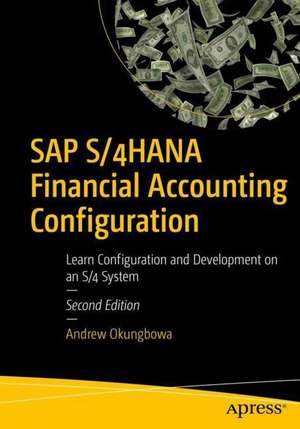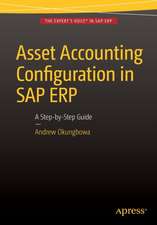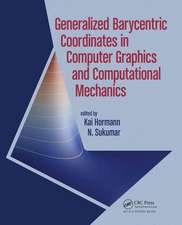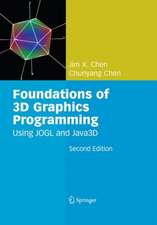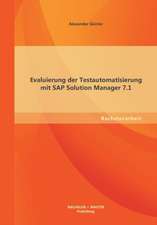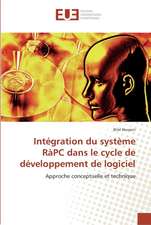SAP S/4HANA Financial Accounting Configuration: Learn Configuration and Development on an S/4 System
Autor Andrew Okungbowaen Limba Engleză Paperback – 25 dec 2022
This updated edition presents new features in SAP S/4HANA, with in-depth coverage of the FI syllabus in SAP S/4HANA. A practical and hands-on approach includes scenarios with real-life examples and practical illustrations. There is no unnecessary jargon in this configuration and end-user manual.
What You Will Learn
Who This Book Is For
FI consultants, trainers, developers, accountants, and SAP FI support organizations will find the book an excellent reference guide. Beginners without prior FI configuration experience will find the step-by-step illustrations to be practical and great hands-on experience.
- Configure SAP FI as a pro in S/4
- Master core aspects of Financial Accounting and Controlling
- Integrate SAP Financial with other SAP modules
- Gain a thorough hands-on experience with IMG (Implementation Guide)
- Understand and explain the functionalities of SAP FI
Who This Book Is For
FI consultants, trainers, developers, accountants, and SAP FI support organizations will find the book an excellent reference guide. Beginners without prior FI configuration experience will find the step-by-step illustrations to be practical and great hands-on experience.
Preț: 320.72 lei
Preț vechi: 400.90 lei
-20% Nou
Puncte Express: 481
Preț estimativ în valută:
61.38€ • 63.69$ • 51.30£
61.38€ • 63.69$ • 51.30£
Carte disponibilă
Livrare economică 24 februarie-10 martie
Preluare comenzi: 021 569.72.76
Specificații
ISBN-13: 9781484289563
ISBN-10: 1484289560
Ilustrații: XXVI, 449 p. 265 illus.
Dimensiuni: 178 x 254 mm
Greutate: 0.9 kg
Ediția:2nd ed.
Editura: Apress
Colecția Apress
Locul publicării:Berkeley, CA, United States
ISBN-10: 1484289560
Ilustrații: XXVI, 449 p. 265 illus.
Dimensiuni: 178 x 254 mm
Greutate: 0.9 kg
Ediția:2nd ed.
Editura: Apress
Colecția Apress
Locul publicării:Berkeley, CA, United States
Cuprins
Chapter 1: Organizational Unit.- Chapter 2: Defining Chart of Accounts.- Chapter 3: Document Control.- Chapter 4: Tolerance Group.- Chapter 5: Creating General Ledger (G/L).- Chapter 6: Clearing Open Items.- Chapter 7: Maintaining Currency Types & Currency Pairs.- Chapter 8: GR/IR Clearing.- Chapter 9: House Bank.- Chapter 10: Tax on Sale/Purchase.-Chapter 11: Cash Journal.- Chapter 12: Financial Statement Versions (FSV).- Chapter 13: Integration of FI with Other SAP S4 HANA Modules.- Chapter 14: Accounts Receivable & Accounts Payable.- Chapter 15: Defining Dunning Procedure.- Chapter 16: ISpecial G/L Transactions.- Chapter 17: Ledgers.
Notă biografică
Andrew Okungbowa is an accountant and a business advisor with 20+ years of experience solving complex business issues. He is an acclaimed author of several books in accounting and finance. He also co-founded Spoxio App, a sports app design for sports professionals, sports enthusiasts, and fans to network on a mobile app.
Andrew holds a combined bachelor’s degree in accounting and IT, a master’s degree in Investment and Finance, and an associate status with the Institute of Financial Accountants. He has over 15 years of experience in SAP FI/CO consulting and over 20 years of accounting and finance experience in a number of FTSE 100/250 companies in the UK and abroad. Andrew has sat on the board of several companies in the UK, such as Changing Lives Housing Trust, and Twenty-Fifth Avenue Ltd.
Andrew holds a combined bachelor’s degree in accounting and IT, a master’s degree in Investment and Finance, and an associate status with the Institute of Financial Accountants. He has over 15 years of experience in SAP FI/CO consulting and over 20 years of accounting and finance experience in a number of FTSE 100/250 companies in the UK and abroad. Andrew has sat on the board of several companies in the UK, such as Changing Lives Housing Trust, and Twenty-Fifth Avenue Ltd.
Textul de pe ultima copertă
Upgrade your knowledge to learn S/4HANA, the latest version of the SAP ERP system, with its built-in intelligent technologies, including AI, machine learning, and advanced analytics.
Since the first edition of this book published as SAP ERP Financial and Controlling: Configuration and Use Management, the perspective has changed significantly as S/4HANA now comes with new features, such as FIORI (new GUI), which focuses on flexible app style development and interactivity with mobile phones. It also has a universal journal, which helps in data integration in a single location, such as centralized processing, and is faster than ECC S/3. It merges FI & CO efficiently, which enables document posting in the Controlling area setup. General Ledger Accounts (FI) and Cost Element (CO) are mapped together in a way that cost elements (both primary and secondary) are part of G/L accounts. And a mandatory setup of customer-vendor integration with business partners is included vs the earlier ECC creation with separate vendor master and customer master.
This updated edition presents new features in SAP S/4HANA, with in-depth coverage of the FI syllabus in SAP S/4HANA. A practical and hands-on approach includes scenarios with real-life examples and practical illustrations. There is no unnecessary jargon in this configuration and end-user manual.
This updated edition presents new features in SAP S/4HANA, with in-depth coverage of the FI syllabus in SAP S/4HANA. A practical and hands-on approach includes scenarios with real-life examples and practical illustrations. There is no unnecessary jargon in this configuration and end-user manual.
What You Will Learn
- Configure SAP FI as a pro in S/4
- Master core aspects of Financial Accounting and Controlling
- Integrate SAP Financial with other SAP modules
- Gain a thorough hands-on experience with IMG (Implementation Guide)
- Understand and explain the functionalities of SAP FI
Caracteristici
Covers new features of SAP S/4HANA Financial Accounting Configuration Includes SAP FI in S/4HANA using a bottom-up approach from basis setup to advanced topics Explains how a flexible system can be set up with SAP suggested best practices
